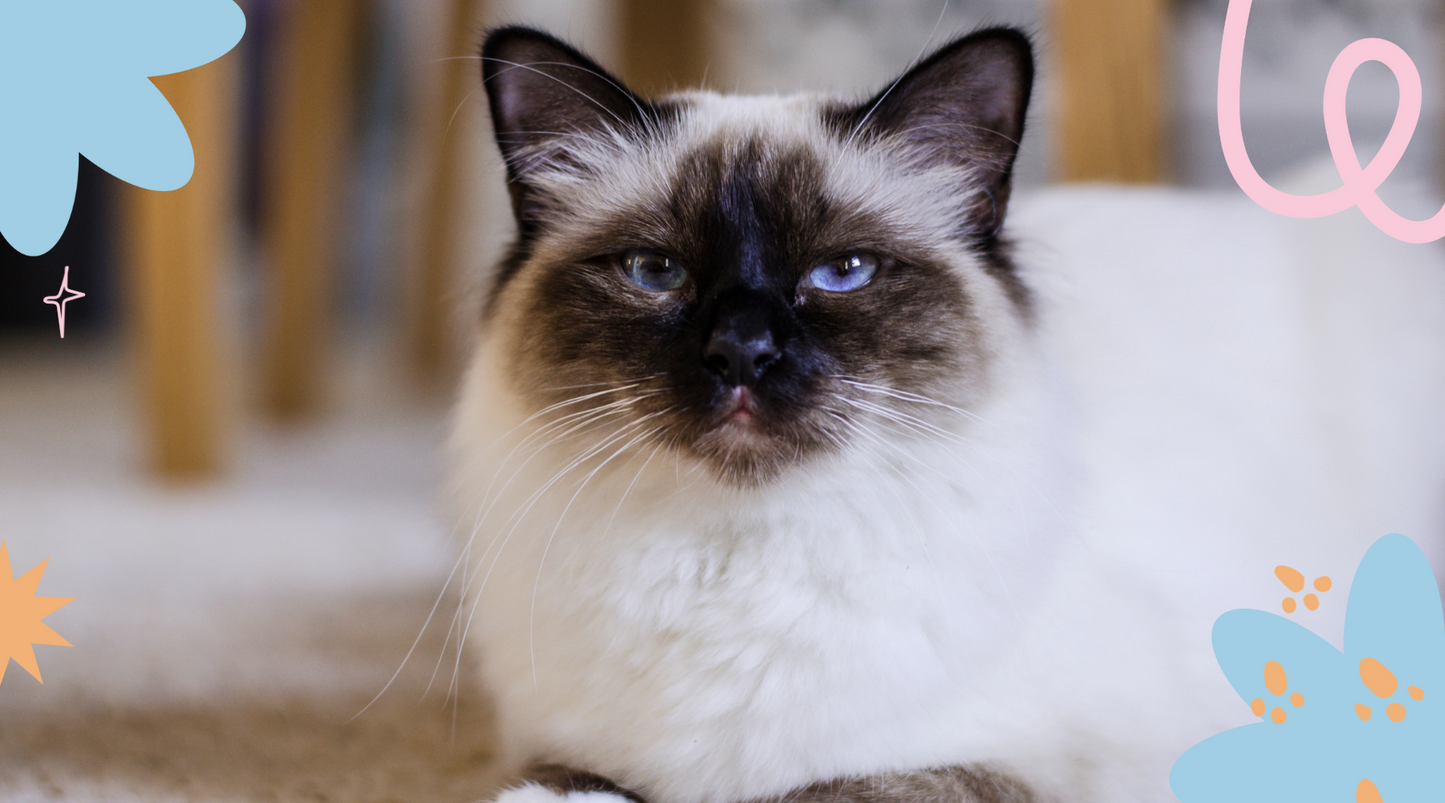
The Burmese cat is a popular domestic feline breed admired for its fun-loving and affectionate personality. Often described as the "clowns" of the cat kingdom, Burmese cats make devoted companions that love being involved in family activities. In this comprehensive guide, we will dive deep into all aspects of this unique cat breed - from their origins, physical features, personality traits, potential health issues, grooming needs, and more. Read on to find out if the lively Burmese cat would make the ideal pet for your household.
Tracing the History and Origins of Burmese Cats
The Burmese cat originated as a breed in America, despite its name being derived from Burma (now Myanmar). The breed's beginnings can be traced back to a female Burmese cat named Wong Mau. She was brought from Burma to San Francisco in 1930 by a sailor named Billie Gerst. Wong Mau grabbed attention for her rich brown coat color, quite unlike the Siamese cats of those times. Legend has it that Wong Mau herself was one of the temple cats of Burma, revered as embodiments of gods.
Dr. Joseph Thompson acquired Wong Mau from Gerst and believed she was unique enough to develop into a standardized breed. In 1936, he imported three more brown cats from Burma and began breeding them with Siamese cats to establish the Burmese breed. At first, they were referred to as Burmese champagne or sable Burmese because of the distinct brown coat color.
The Cat Fanciers Association formally recognized the Burmese breed in 1936. Gradually, breeding programs introduced new colors like blue, platinum, and lilac. Today, Burmese cats remain highly popular in the United States and their native Southeast Asia. They rank among the top 10 most popular pedigreed cats in America.
Size, Appearance and Distinct Features

The most notable feature of Burmese cats is their sleek, glossy coat that drapes tightly over their muscular bodies. They have a medium build with rounded contours on their head, ears, eyes, and feet. Adult Burmese cats typically weigh 6 to 10 pounds when fully grown.
The head is wedge-shaped with slightly rounded ears set wide apart. Their most mesmerizing feature is perhaps the large, expressive eyes that gleam like gold and gems. Eye color ranges from yellow to amber and green. The short, silky coat lies close to the body with no undercoat.
Burmese cats are known for their various coat colors and patterns. While the original brown Burmese is still popular, many new shades emerged over time like blue, champagne, platinum and lilac. Some rare colors found are fawn, tortoiseshell, and cream. Kittens are generally lighter than adults. The satin-like single coat requires minimal grooming.
Personality and Temperament Traits

So what accounts for the charismatic appeal of Burmese cats? Much of it comes from their outgoing, playful personality which makes them extremely endearing. Burmese cats are highly social and form strong attachments to their human families. They thrive on interactive play and lots of quality time with their owners. Affectionate and loyal by nature, the Burmese do not like being ignored and left alone for too long.
The typical Burmese cat is highly intelligent with a charming disposition. Their energy and curiosity make them fast learners. Burmese cats can play fetch, learn tricks, and even walk on leashes. Some exhibit dog-like behavior in the way they follow owners from room to room. When properly trained, Burmese cats generally get along fine with children, other cats, and calm dogs. Overall, they make delightful and lively family pets.
Common Health Issues Seen in Burmese Cats

Most Burmese cats enjoy excellent health, especially when acquired from ethical breeders. Selecting reputable catteries that health screen their breeding cats helps minimize genetic issues. However, certain health conditions may be seen in some lines.
Hypokalemia, a potassium deficiency causing muscle weakness, is probably the most common inherited disorder found in Burmese cats. Dental issues like gingivitis can also occur. Other potential concerns like heart murmurs, asthma, cancer, and joint problems are occasionally seen in the breed.
To enjoy a long, healthy life, have your Burmese cat undergo routine veterinary checkups, keep vaccinations updated, and feed a nutritious diet. Early spaying/neutering prevents reproductive cancers. Providing a stimulating home environment also keeps their body and mind active.
Fun and Fascinating Facts About the Burmese Breed
- In their native Southeast Asia, Burmese cats were considered as living jewels and bearers of prosperity.
- The first Burmese cats imported to America were said to be wrapped in silk for their ocean voyage.
- Burmese cats contribute to creating new breeds like the Tonkinese and Burmilla.
- Their lifespan is usually 12 to 16 years with proper nutrition and preventive veterinary care.
- Burmese cats enjoy playing in water. Keep a water fountain to entice them!
- American Burmese differ from British and European Burmese in their build and head shape.
Grooming Needs and Shedding Patterns

The short, glossy coat of Burmese cats rarely mats or tangles. Their silky fur consists of only a single topcoat with no fluffy undercoat. Shedding is also minimal, making them relatively easy to groom.
Gentle brushing once or twice a week removes loose hair and distributes skin oils for a glossy coat. Use a stainless steel comb for smooth efficient grooming without irritation. Pay attention to commonly missed areas like behind the ears, underside, and legs.
Bathe a Burmese cat only when necessary using a mild cat-safe shampoo. Trim nails every couple of weeks and check ears for cleanliness when grooming. Proper dental hygiene is also important for preventing gum disease. Get your Burmese cat accustomed to grooming from kittenhood for stress-free handling later.
Key Considerations Before Getting a Burmese Cat

While Burmese cats make delightful pets for many owners, they are not the right match for everyone. Here are some key points to think over before getting one:
- Burmese cats demand a good amount of interactive playtime and environmental stimuli. Without adequate exercise and engagement, they may act out through unwanted behavior.
- Their highly social nature means Burmese cats should not be left alone for long periods every day. They thrive on companionship.
- Burmese cats get attached to their families and need plenty of love and attention. They do not do well in homes where they are frequently ignored.
- Early socialization is vital for them to comfortably live with other household pets.
- Burmese cats are quite vocal in communication. Make sure their chatter does not disturb neighbors in shared housing.
- Be ready to keep up with their active and inquisitive temperament. A bored Burmese can get into all kinds of mischief!
- Ensure you can provide for their healthcare, food, litter, toys and other expenses before adopting a Burmese cat.
Final Summary of the Playful yet Loyal Burmese Cat
- Originated in Southeast Asia, later developed as a breed in America
- Medium-sized muscular body with a short, glossy coat
- Come in a variety of colors like brown, blue, champagne, platinum
- Distinctive for their gold, yellow, or green eyes
- Intelligent, energetic and extremely affectionate
- Thrive on interactive play and quality time with owners
- Form close bonds with families when given attention
- Adaptable cats that get along with other pets
- Occasionally prone to health issues like hypokalemia
- Require minimal grooming and maintenance
- Not recommended for frequently empty homes
In summary, Burmese cats make charming and devoted companions when placed in active, engaging homes where they get ample time with their loved ones. Their playful spirit, loyalty, and interest in everything make them a wonderful breed for those who can shower them with care and affection. If you can provide the right environment, a Burmese cat promises to be a lively and steadfast family pet.
